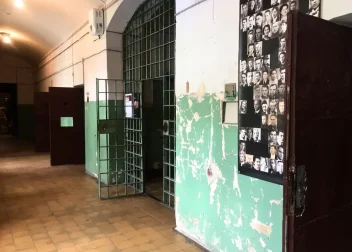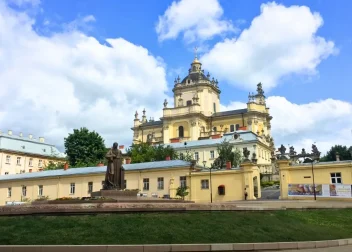Things to Do in Lviv
Why Lviv?
One of the biggest reasons is that it’s economical. Both plane tickets and accommodations, as well as food and drink, are quite affordable. I’ll go into more detail about the dining options later, but even when dining at luxury restaurants, it’s not an expensive city. The currency is Hryvnia (UAH). The fact that it’s a visa-free destination is another convenience.
The Austrian-style architecture in the city might make you feel like you’re in Prague or Vienna at times. Don’t be fooled by the Soviet-style buildings you see when you first exit the airport. The architecture waiting for you in the city center is entirely different. While the narrow streets and cobblestone roads can be a bit of a traffic hassle, exploring on foot is quite enjoyable. These roads were once made for horses, and renewing them today would mean losing some of the historical texture, so traffic jams are inevitable.
You won’t have trouble finding food you like at the restaurants because the way they cook their meat or the ingredients they use suit our taste.
It’s a green city, with plenty of parks and forests. You’ll find areas where you can breathe fresh air both in the city center and on its outskirts.
Accommodation in Lviv
There are many hostel, hotel, or apartment options for accommodation. Hostels are quite affordable, and some even offer 2-3 person rooms. Hotel prices are reasonable, and since the city isn’t very big, most places can be considered centrally located.
We stayed at the Ibis Styles Lviv Hotel with a bed-and-breakfast setup. We were quite satisfied with the location and services of the hotel. At breakfast, you can find eggs, butter, cucumbers, tomatoes, cheese, salami, and sweet pastries. One of our favorite features was that bottled water could be picked up for free from the lobby. The space that also served as the hotel’s breakfast area was one of the famous pizza chains in the city, Celentano Restaurant.
Transportation in Lviv
The buses in Lviv are old, small, and crowded. Even the bus that leaves from the airport starts to get packed by the second stop. However, it’s worth noting that the prices are quite affordable. The more affordable public transport option is the tram, but from what I saw, the trams were also very crowded. We took the bus to get there and a taxi on the way back.
Within the city, you can walk almost everywhere. Considering the crowded public transport and traffic, you’ll agree that walking is the best option 🙂
Places to Visit in Lviv
When you look at blogs about Lviv, you’ll see that they all mention the same places. Unfortunately, this is the case with foreign sources too. Still, after thinking about what I’ve read and experienced, I observe once again that everyone’s experience can be different. Also, if you have someone with you who speaks Russian, you’ll end up interacting with people, especially older folks, more often and learn some interesting facts. I’ll sprinkle some of those details throughout this article. (By the way, although people speak Russian, many aren’t eager to use it, and there’s a significant nationalist group that insists on responding in Ukrainian.) We didn’t get a chance to go, but I’ll write about the castles near Lviv in case you’d like to visit.
Churches are everywhere in the city, and it wouldn’t be an exaggeration to call it the “city of churches.” After a while, you start asking yourself whether you’ve visited this church before or if it’s the same as the one nearby. If you find yourself wondering which church to visit or skip, you can check out my Churches in Lviv article for more detailed information.
The Lviv Town Hall, located right in the middle of Rynok Square, offers a great spot to photograph the city from its rooftop. However, I should warn you that the stairs seem endless.

Another spot where you can take panoramic photos of Lviv is High Castle. Although I think the view from the Town Hall is better, climbing here is a good choice for seeing Lviv’s greenery. There’s no fee for climbing up. Many blogs talk about how tough the climb is, but we passed through Shevchenko Park, so we only climbed a few steps. Of course, we didn’t avoid some narrow forest paths, but we got plenty of fresh air in the end 🙂 Don’t be misled by the term “park”—it’s practically a forest. Even if you don’t go through the park, you can reach High Castle by entering from the parking lot where Maksyma Kryvonosa and Opryshkivska Streets intersect, and then taking the left path when the road splits.
Next to the park, we saw signs for a museum, and it turns out it’s the Folk Architecture and Rural Life Museum, an open-air museum depicting traditional Ukrainian life. It’s not on most maps, and I was sad to have only learned about it afterward. (Many blogs mentioned that it’s too far to walk to, but for us, it was a very walkable distance.) We were in the forest in less than half an hour from the cemetery, and from there, it’s a 15-20 minute walk to High Castle.
The Lychakiv Cemetery is a cemetery where many famous Ukrainians have their statues, and even for the unknowns, there are interesting graves. What struck me the most was a photo of two devastated people. The cemetery offers a quiet, bird-filled, and at times melancholy visit.

The Potocki Palace was built by a Polish architect from the design of a French architect, commissioned by the Polish Potocki family. The ground floor consists of gala halls, each with a different name (Red Hall, Blue Hall, and Mirror Hall). Today, the halls house the European Art Museum, where paintings from the 14th-18th centuries are exhibited. There’s an entrance fee to visit the inside of the palace, and right next to it is the Lviv Art Gallery, which also charges for entry. One thing to note is that you can’t enter until after 11 AM. We didn’t go inside. You can enter the garden and photograph the palace from the outside, and the street where the palace is located is the famous one with the colorful umbrellas in Lviv.
The Memorial Museum on S. Bandery Street, housed in an old prison, was one of the most impactful places for us. The entrance is free, and don’t think the museum is closed if the door is locked; it’ll open if you push it. This place allows you to witness the wars Ukraine has experienced. It’s a prison with a 127-year history that saw torture during the Polish, Nazi, and Soviet regimes. One of the elderly museum staff shared some information with us, thanks to our Russian-speaking friend, which made the visit even more meaningful. For more detailed information, you can check out my article on this museum.
The train station is a beautiful station to look at, but I didn’t see anything in its interior that made it different from other stations. As we left the station and headed toward the main road, we stumbled upon a market on one of the streets across from the station. I’m not sure if it’s there every day, but the strawberries we bought were quite tasty. On the way back, we learned from our taxi driver that there are two train stations in Lviv. I don’t know if we went to the nicer one or if there’s an even better one. Feel free to investigate.
Lviv Town Hall‘s rooftop offers a view of a striking red-roofed building that will likely catch your attention. This charming structure is the Fire Station/Emergency Services building, and its exterior is just as appealing as its roof. Nearby, you’ll also find the Royal Arsenal, marked on the map, which was unfortunately closed when we visited, as it’s now used as a state archive. I have to say, it’s not particularly remarkable from the outside.
The Italian Courtyard on Rynok Square is currently used as a restaurant, and while you can pop in for some photos, we didn’t find it particularly special. The Postal Museum was closed, and we weren’t too impressed by the Pharmacy Museum either.

The Lost Toys Courtyard on Mukachivska Street was another hard-to-find location, as it wasn’t marked on most maps. If you’re tired, you might want to skip it. We gave up on the first day but managed to find it on our last day when we had some extra time. It’s a courtyard that’s visible from the street in a residential building (I’ll share a photo below to help you locate it). It’s colorful, fun, and we had a good time there.
Wandering aimlessly through the streets to discover old houses, cobblestones, and art is also enjoyable—you never know what you might stumble upon. For instance, just as we were about to leave, we discovered beautiful buildings in the backstreets behind our hotel—unfortunately, a bit too late!
There are castles about 1-1.5 hours away from Lviv by car. We didn’t manage to visit them, but if you’re staying for more than three days, you might want to include a day trip to the castles. There are full-day tours to Olesko, Zolochiv, and Pidhirtsi Castles that are organized through hotels or available at tourism offices. These tours usually start between 8-10 AM, so it’s best to book at least a day in advance. Alternatively, you can take a bus to Olesko and Zolochiv on your own. is a park located right behind one of the universities, and it’s ideal for a breath of fresh air. Although it was very close to us, we didn’t get the chance to sit down and relax here. It seemed lively during the day, but the atmosphere in the evening was different, especially when the benches filled up with couples.

